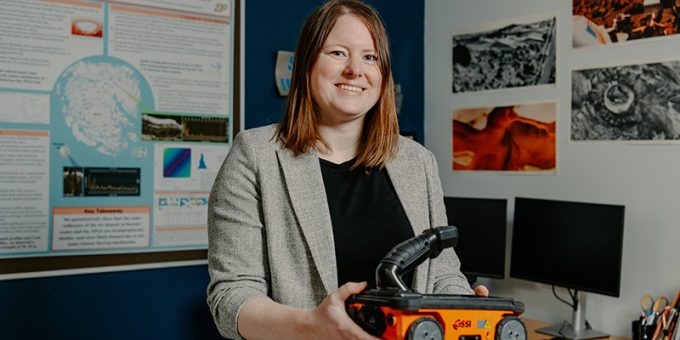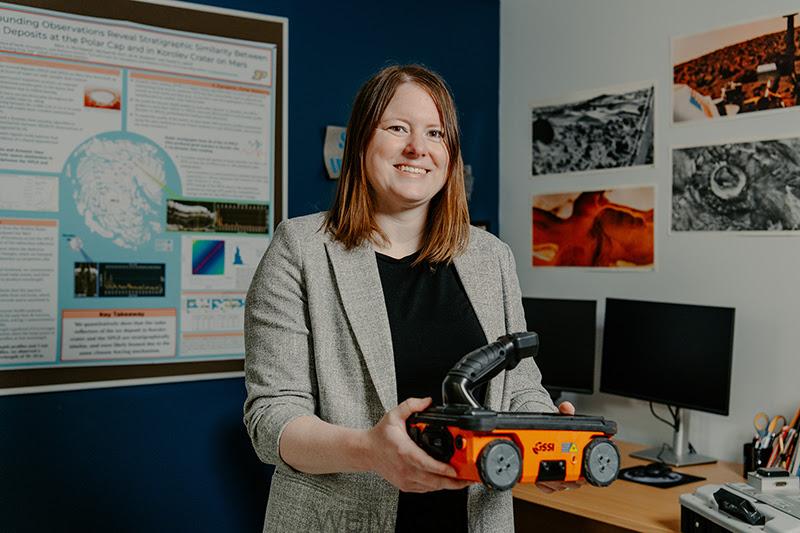
WEST LAFAYETTE — To survive on other planets, water is, of course, critical. We need it to drink, sustain crops, and even create rocket fuel.
But on spaceflights, checked luggage is exorbitantly expensive. Anything heavy, especially liquids like water, is bulky and costly to haul by rocket, even to our closest interplanetary neighbors. The best plan is to find water at the spacecraft’s destination.

Purdue University planetary scientist Ali Bramson’s research lays the foundation for future extraterrestrial exploration. She is focused on finding ice deposits beneath the barren surfaces of the moon and Mars, providing a buried resource vital for future human habitats and space travel. Subsurface ice is also a compelling target for astrobiology, climatology, and geology research.
Bramson continues work that began with Mars through NASA’s Subsurface Water Ice Mapping project. Radar analysis from spacecraft orbiting Mars probed beneath the planet’s surface, looking for indicators of where ice is likely located across the planet. Data from spectrography and visual imagery also was utilized in the project.
“We can see ice on the surface at Mars’ poles, and we’re beginning to understand how much is buried under the subsurface at lower latitudes as well,” said Bramson, an assistant professor in the Department of Earth, Atmospheric, and Planetary Sciences in Purdue University’s College of Science. “But we still don’t have a good understanding of how much subsurface ice could be on the Earth’s moon.”
Bramson’s findings will offer early ideas about where future habitats on both the moon and Mars could be located, in terms of use by astronauts as well as travel capabilities; water can be used as part of the fuel for rockets.
Mars has two large ice caps at its poles, which combined contain about the same amount of ice as Greenland. But winter at Mars’ poles lasts several months without sunlight, making temperatures at the poles less than favorable. Areas with signs of widespread ice beneath the surface were found in the middle latitudes of Mars’ northern hemisphere, making those areas more hospitable for future human habitats.
Bramson’s work is already moving from examining radar findings provided by orbiting spacecraft to exploring the potential of mobile cartlike radar systems on the ground.
“These systems can send radio waves into the ground and then listen for a signal to bounce off of materials in the subsurface,” she said. “The systems can help us learn about what is in the subsurface without having to use destructive techniques to find it.”
Research plans in 2024 include testing different versions of the land-based radar systems in Iceland by searching for buried snow deposits covered by ash from volcanic eruptions. Additional testing at Purdue will evaluate the radar’s capabilities to measure layers of ice and dust in simulated Martian conditions, using a walk-in freezer at negative 20 degrees Celsius (negative 4 degrees Fahrenheit).
Bramson will be presenting at two international conferences later this year about Mars’ ice layers and how they form. She was also honored by NASA recently as part of the Measurement Definition Team of the International Mars Ice Mapper mission concept, and was selected by the National Academies of Sciences to study the science that could be accomplished by astronauts on Mars.
Bramson’s research is funded through NASA’s Mars Data Analysis, Lunar Data Analysis and Solar System Workings programs.
The potential for subsurface ice on the moon is seemingly low compared to other planets. Bramson said the current thinking is that there may be only 3% ice within and under the surface. That’s compared to red-hot Mercury — the closest planet to the sun — where large ice deposits have been detected.
“Even though Mercury is so close to the sun that it’s super, super hot, there are areas within craters near the poles that never see the direct sunlight because they’re in permanent shadow, and that’s cold enough to actually retain massive ice deposits,” Bramson said. “We initially thought the moon would be similar, since it has similar permanently shadowed regions, but it seems like there’s not these massive ice deposits like Mercury has.”
Bramson said the presence or lack of ice deposits on Mars and the moon raises a number of questions for her.
“It’s really interesting from a science point of view to understand what are the conditions that led to ice being present in various locations on different planetary bodies,” Bramson said. “Today, some of these latitudes of Mars are too warm to form these ice deposits there. This ice, therefore, represents a record of the climate conditions on Mars in the past. Meanwhile, differences in the ice deposits on Mercury and the moon may tell us about different mechanisms that bring water to these objects in our solar system.”
Information: Brian Huchel, bhuchel@purdue.edu
Source: Ali Bramson, bramsona@purdue.edu



